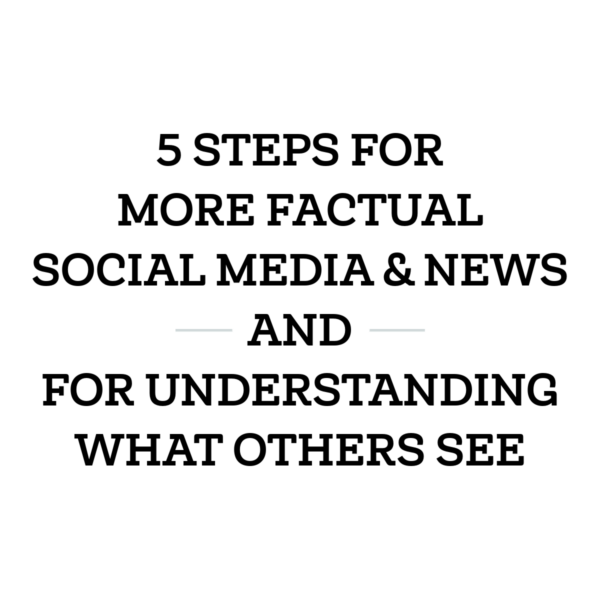The following has worked for me in two regards:
- It helps me increase the chances that I am reading/believing factual news, information, and stories across social media.
- It also helps me see what people who are NOT reading media outlets that focus on facts are reading/believing.
Different people have different methods, but here’s what I’ve been doing. I hope it helps you, too.

✅ STEP ONE
Follow news/media outlets grouped by category.
I find this is easiest to do on Twitter, but it can also be typed up and kept in a phone Notes or a document on your computer.
Categories:
- Mostly Unbiased and at least highly factual.
- Slightly Left-biased and at least highly factual.
- Slightly Right-biased and at least highly factual.
- Left-biased and at least highly factual.
- Right-biased and at least highly factual.
- Extreme Left-biased.
- Extreme Right-biased.
(Following the spectrum of biases and factual ratings of media outlets to see what EVERYONE is seeing is quite insightful. I’ll get to how in step four.)
Make “Mostly Unbiased and at least highly factual” my default.
Check the bias AND factual rating of sources here:
- Option 1: Media Bias Fact Check
- Option 2: Adfontes Media
- Option 3: All Sides
Note: There is no absolutely flawless way to check the ratings, and the ratings for each source/media outlet will fluctuate. There are lots of variables to consider, and there are various ways to check the ratings (websites, extensions, apps, etc.). The point is to cross-check each media source/outlet, get a selection of them in each category, and check in now and again to see if the sources need to be moved to different categories.
✅ STEP TWO
Also follow experts who are often interviewed/quoted as reliable sources for certain categories of information in those articles from Highly Factual media outlets. Like:
- Science (doctors, scientists, environmental experts, etc.)
- Government (historians, political analysts, professors who specialize in the subject, etc.)
*** Make sure to include typically marginalized voices. Do not whitewash these lists. Be deliberate about including voices from people of all backgrounds, abilities, cultures, races, religions, genders, identities, economic statuses, etc. ***
✅ STEP THREE
Keep fact-check sites at the ready, so before I share something I can make sure it has been confirmed as true. Like:
- Snopes
- AP Fact Check (by the Associated Press)
- Politifact
- FactCheck.org
If it’s not confirmed yet or “happening now” or the like, be clear in my commentary so my share is not mistaken as fact.
✅ STEP FOUR
Once a week (and whenever something “big” is going on), go and deliberately look at the social media feed that falls under the “Extreme” lists.
Doing so helps me understand why people who only follow/see those posts have such different truths, which drive their fears, passions, choices. It clarifies divides, and keeps me from being in my own bubble.
✅ STEP FIVE
Remember that I’m human.
If I make a mistake, delete the post. Apologize. Edit my commentary to clarify. Share a better post/source. Do better next time.
AND IN CASE YOU WANT THEM…
Here are my current newsy Twitter lists, which get updated regularly. Feel free to follow them, but I also encourage you to build your own.
- Mostly Unbiased and at least highly factual.
- Slightly Left-biased and at least highly factual.
- Slightly Right-biased and at least highly factual.
- Left-biased and at least highly factual.
- Right-biased and at least highly factual. N/A
- Extreme Left-biased.
- Extreme Right-biased.
Hope that helps!

Kim Bongiorno is a freelance writer and author. You can find her on Twitter, Facebook, and Instagram any day, or read her most recent essay “Reading is Fundamental (to Raising Teenagers)” in the anthology I JUST WANT TO HANG OUT WITH YOU.
Leave a Reply